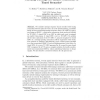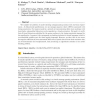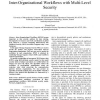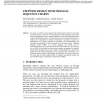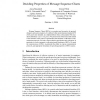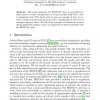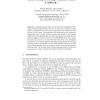IANDC
2010
14 years 4 months ago
2010
We consider message sequence charts enriched with timing constraints between pairs of events. As in the untimed setting, an infinite family of time-constrained message sequence cha...
FSTTCS
2010
Springer
14 years 5 months ago
2010
Springer
We consider the problem of model checking message-passing systems with real-time requirements. As behavioural specifications, we use message sequence charts (MSCs) annotated with ...
JCP
2008
14 years 7 months ago
2008
Inter-Organizational Workflows (IOWF) become important as they provide solution for data sharing, heterogeneity in resources and work coordination at global level. However, a secur...
FORTE
2001
14 years 8 months ago
2001
Use cases are useful in various stages of the software process. They are very often described using text that has to be interpreted by system designers. This could lead to implemen...
DAGSTUHL
2003
14 years 8 months ago
2003
Message Sequence Charts (MSCs) is a notation used in practice by protocol designers and system engineers. It is defined within an international standard (ITU Z120), and is also i...
FORTE
2007
14 years 8 months ago
2007
This paper proposes an algorithm which, given a set of observations of an existing concurrent system that has repetitive subfunctions, constructs a Message Sequence Charts (MSC) gr...
APN
2006
Springer
14 years 10 months ago
2006
Springer
Abstract. This paper describes the BRITNeY suite, a tool which enables users to create visualizations of formal models. BRITNeY suite is integrated with CPN Tools, and we give an e...
APN
2006
Springer
14 years 10 months ago
2006
Springer
A netchart is basically a Petri net whose places are located at some process and whose transitions are labeled by message sequence charts (MSCs). Two recent papers showed independe...
FCT
2007
Springer
14 years 11 months ago
2007
Springer
Abstract. Message sequence charts are an attractive formalism for specifying communicating systems. One way to test such a system is to substitute a component by a test process and...
CONCUR
2007
Springer
14 years 11 months ago
2007
Springer
We consider message sequence charts enriched with timing constraints between pairs of events. As in the untimed setting, an infinite family of time-constrained message sequence cha...
